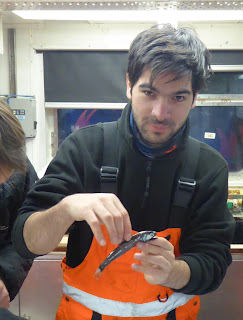E como é fazer ciência
na Nova Zelândia? Bem, possui grandes vantagens...mas são as pequenas coisas
que fazem toda a diferença. Estes apoios atuais do Programa Polar Português
permite ir a institutos estrangeiros para analisar amostras que foram
recolhidas por colegas (neste caso Nova Zelandeses), reduzindo os custos (pois já
não é necessário ir à Antártida (ou área de estudo) recolher amostras, que
exige elevados custos das viagens, equipamento, burocracias, e muito tempo
disponível para ir) e maximiza os resultados (pois assim permite ter mais tempo
no laboratório a analisar as amostras, e escrever os artigos científicos).
Com
esta colaboração, que se estende para mais de 5 anos, os resultados vão desde
artigos científicos, reforçar esta colaboração cientifica com colegas da Nova
Zelândia, e ligações à educação e à diplomacia, beneficiando ambos os países.
Mas ainda há mais...aprende-se a apreciar um diferente modo de vida ao fazer
ciência, o que ajuda os cientistas portugueses a serem melhores cada dia. Assim
que se chega a Wellington, longe da Europa, és logo acariciado por um calor
ameno assim que chegas. Sim, é Verão!!! Sendo Wellington junto ao mar, um dia
de sol torna-se num magnifico dia. Os gelados (provar Hokey Pokey é uma
obrigação; cujo sabor é de baunilha e pepitas de caramelo) são fantásticos. E
como estamos perto da Antártida, alusões a pinguins é constante (batatas
fritas, por exemplo).
Vê-se muita gente a correr, na praia da cidade (pequena
mas acolhedora), competições de barcos Maori (a cultura Maori está à nossa volta
constantemente, o que é muito bonito), e...muitos Europeus: existe um rumor que
60-70% dos habitantes de Wellington são europeus!!! A moeda é diferente do
nosso Euro (New Zealand Dollars) e o que vi de Portugal foi as famosas
sardinhas no supermercado. És logo convidado para jogar futebol (é logo “amigo”
do Cristiano Ronaldo, que é confundido por apenas de sermos do mesmo país).
No
instituto, o modo de trabalhar é exemplar. Tens de seguir numerosas regras de
segurança e de saúde no trabalho, que é levado muito a sério, o que nos ajuda a
compreender as diferenças entre estes sistemas de trabalho europeu com o Nova
Zelandês. O profissionalismo de todos é de enaltecer. Esta semana foi
literalmente dentro do laboratório a ajudar a terminar as análises das amostras
do José Queirós vindas da Antártida (José partiu na Quarta-feira) e começar com
as minhas amostras de lulas vindas da dieta de albatrozes...mas explicar o que
estou a encontrar fica para a semana
And how is to do
science in New Zealand? Well, there are numerous advantages...but are the
little things that makes all the difference. Today´s research support of the
Portuguese Polar Programme allows scientists to go to research institutes to
analise samples collected from colleagues (in this case, from New Zelanders),
reducing the costs (as there is no need to go to the Antarctic/research áreas that
requires high travel costs, equipment, burocracy and lots of time available)
and maximizes the results (as it allows more time to be in the lab analising
the samples, to write the research papers, reenforce the scientific
collaboration with New Zealand, beneficial to both countries). With this
collaboration, that goes over 5 years now, the results go from research
scientific papers to education and diplomacy. But there is more than that...
It allows the
scientists, under this scheme, to appreciate a diferente way of life in doing
science, which helps the portuguese scientists to be better everyday. As soon
as we arrive in Wellington, well far from Europe, a nice warmth welcomes you.
Yes, i tis Summer here!!! As Wellington is by the Sea, a sunny day is a wonderful
day.
The icecreams (tasting Hokey Pokey is a must; the flavour is vanilla and
caramel) are excellent!!! And as we are fairly close to the Antarctic, products
with pinguins is common (such as fries packets). There is always people running
in the promenade, on the city beach (small but cosy), competitions of boats
Maori (the Maori culture is nicely everywhere, which is really nice) and...lots
of Europeans: there is a rumour that 60-70% of the habitants in Wellington are
Europeans!!! Here, we use New Zealand Dollars (no Euros around) and from what I
have seen, only have seen our Portuguese famous sardines in the supermarket.
When you say you are Portuguese, you are immediately invited to play football (you
are seen as a “friend” of Cristiano Ronaldo, despite not playing like him). In
the research institute, the work ethics is exemplar. Numerous rules on Health
and Safety must be followed, ands are taken very seriously. I tis really importante
for our education to understand the diferences between the work systems between
New Zealand and Europe, and both function well! The profissionalismo of
everyone is worth mentioning. This week was literally spent inside the lab,
helping finishing the analyses of samples from the Antarctic of José Queirós (José
left on Wednesday) and started with my samples from the diet of
albatrosses....but I will explain more details on this work soon


































